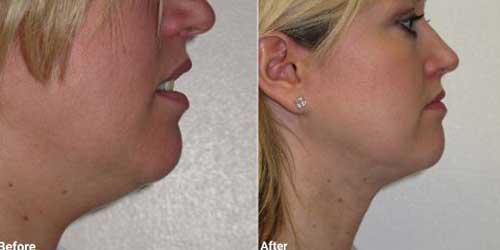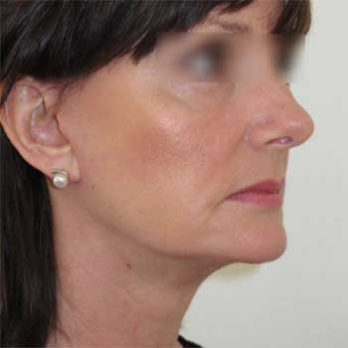
Mini Facelift Surgery
A mini-facelift is only useful for younger patients in whom the ageing changes predominantly affect the face, jawline and jowls but have not yet caused any issues in the neck. This means the average age of patients suitable for this surgery is in their 40s but very occasionally someone in their early 50s can sometimes benefit . After this age the laxity of the skin and muscles in the neck becomes more noticeable and a standard facecelift combined with some form of necklift is usually required.
A mini-facelift is a surgical procedure which has a shorter scar compared to a standard facelift. The surgical technique involves a reduced elevation of the skin compared to a standard facelift and therefore has an improved recovery time. Various terms have been applied to this operation such as ‘mini-facelift’ , ‘MACS’ lift or ‘short scar’ facelift. Essentially these are simply minor modifications of the exact technical way in which stitches are placed and no studies have shown that any technique is better than the other. The most important factor is that the procedure is appropriately tailored to suit the requirements of the patient.
What happens during the operation ?
In a mini facelift the skin is elevated using an incision which is hidden in the natural curves in front of the ear but occasionally may have to extend for a short distance in the groove behind the ear. The skin is elevated in the cheek and along the jawline. The deeper tissues are then elevated using stitches to reposition the facial tissues into a higher and more youthful position. The exact manner in which this is achieved will vary. The ‘MACS’ lift uses long loops of stitches to suspend the tissues from anchor points in front of the ear. Other more standard ‘short scar’ techniques use individual stitches to produce the elevation. The exact technique is not important since the crucial determinant is to tailor the surgery individually in each patient. This may also involve other minor procedures such as a small amount of liposuction under the chin which enhances the neck and jawline contour.
After the elevation of the deeper tissues the excess loose skin is trimmed away and the skin is sutured very carefully around the ear with delicate stitches. A dressing will be applied to produce some gentle compression in the few hours after surgery.
What anaesthetic is required ?
A mini facelift can be performed under local anaesthetic combined with sedation. However, since this surgery can take approximately 2 hours dome patients may find it more comfortable to be completely asleep. The fact that a local anaesthetic procedure is possible means that many patients are attracted to this possibility. However, the level of sedation is quite heavy and this means that there is really not much difference in whether you are asleep in a ‘twighlight’ anaesthesia under heavy sedation or whether you are completely asleep. The exact form of anaesthetic will be carefully discussed with you during the consultation. In reality, quite a few patients have other small additional surgery such as eyelid surgery, liposuction under the chin or some fat transfer all of which enhances the results of facial rejuvenation. Therefore, the majority of patients will need a general anaesthetic.
What is the recovery ?
It is advisable to stay the night in our London hospital. A dressing which is applied around the face is removed the next morning. Your hair will then be carefully washed by the nurses. When you return home it is important to sleep upright for the first few days and to be careful not to lift heavy objects and to avoid stooping. Taking it gently will reduce the swelling and bruising. The degree of bruising is variable but tends to be minimal with a mini-facelift. Any visible bruising subsides by two weeks. You can cover with make up provided you keep away from the stitches around the ear.
The stitches are removed at 5 – 7 days after which you should feel generally quite comfortable. Some patients experience a tight feeling but usually there is very little discomfort from this operation.
After 2 weeks it is acceptable to return to work but there will still be some very minor swelling which takes another 3 to 4 weeks to completely settle. However, during this stage it should not be overtly visible that you have had surgery. It is best to refrain from heavy exercise for approximately one month post-surgery.
The best results are seen at approximately 3 months by which time the tissues have settled. However, the cheek area can feel somewhat numb and it can take a few months for the full sensation to return.
What do the scars look like ?
The scars from a mini facelift are quite inconspicuous and very well hidden in the curves in front of the ear. There may be an early phase where the scars are a little pink in discolouration which is normal but they will then continue to mature. After a few months they will fade but it can take up to one year before they have matured completely.
What are the risks ?
There is generally a low incidence of risks following a mini facelift procedure.
The risks of this operation are higher in smokers and if you smoke it is important to completely stop several weeks prior to surgery. If you are a heavy smoker and you cannot stop smoking you will be unsuitable for surgery.
Infection is a risk but you will be given prophylactic antibiotics which means that this situation is very rare.
Bleeding is a risk which can result in a situation called a haematoma . This is a swelling under the skin which will mean a return to the operating room to remove the swelling and stop any bleeding point. It is not life threatening and will not compromise the result of the surgery. However, there can be a little more bruising during the recovery phase. This situation occurs in about 2 – 3% of patients and if it occurs it is usually identified in the 1st day after surgery
The skin of the cheek will lose its sensation but this gradually returns over a period of a few months. During this recovery phase there may be some minor symptoms like pins and needles or some itching. This is nothing to be worried about and is part of the normal recovery.
Delayed healing of the skin can occur adjacent to the scars. This results in a thick leathery scab which will take some time to separate and heal. It can mean the scar may be thicker than usual and may need further minor intervention to improve the quality of scar. This is more common in smokers and therefore it is imperative you do not smoke prior to surgery.
Damage to the facial nerve is rare during facelift surgery but in particular this is exceedingly rare during a mini face lift.
-
Mini-facelift in 39 year old


This patient had a mini-facelift combined with VASER liposuction to the submental region. This has greatly redefined her jawline providing a more youthful appearance. She was featured in the Daily Mail in a feature where I was asked to comment on my experience of facelift surgery in 40 year olds.
‘I had some bruising, swelling and soreness, but it all calmed down very quickly,’ says Cara. ‘I had stitches in my chin and in front of my ears but the scarring is minimal. I was back at work within a week and colleagues said to me: “You look really well. Have you lost weight?” The effects are so subtle that it’s hard to tell I have had anything done. I feel as if I have “my face” back now and I can’t stop smiling when I look in the mirror.’

-
Mini-facelift and submental liposuction in 40 year old


Kerry was 40 years old and had a a mini-facelift, submental liposuction and blepharoplasty. Even in a 40 year old great results may be achieved by selecting the right combination of procedures which are individualised to the patient. She featured in a Daily Mail article where I was asked to provide expert comment on how such surgery can benefit patients.

Read the article below......
One such patient is Kerry Parsons, 44, an accounts administrator who lives in Buckhurst Hill, Essex, with husband Russell, 44, a contracts manager, and their 12-year-old son. She underwent a facelift aged 40.
‘I’ve always been slim but even when I weighed less than 8st, I had a fat face with jowls and a double chin,’ says Kerry.
‘I was so self-conscious. If another car pulled alongside me while I was driving, I’d instinctively raise my hand to cover my jawline. I never considered fillers or Botox as a puffy pillow face didn’t look youthful to me.
'My husband knew how I felt and he suggested I have a facelift for my 40th birthday present.’
In July 2008, she underwent a short-scar facelift (SSFL) – the same type Louise is suspected to have had – with Jag Chana, cosmetic surgeon at Spire Bushey Hospital in Hertfordshire.
Says Kerry: ‘Mr Chana told me I was a bit young but otherwise a perfect candidate. He also suggested I had liposuction on fatty areas and an eyelift.
'My friends and family told me it was bound to go wrong but I trusted Mr Chana completely.
‘When I woke up from the operation, I was in lot of pain and so swollen I looked like a monster. My sister-in-law came to visit and was so horrified she felt sick.
‘After a week, the swelling settled down, I could see my new face and I was thrilled.
'Mr Chana told me I had so much loose skin that when he pulled it back during surgery, it covered my ears. It took two weeks to feel fully recovered. I went to school to pick up my son and friends told me I looked about 16.
‘I am still ageing but the facelift has lasted brilliantly, my scars are hidden behind my ears, and even six years on, I look so much better than I did in my 20s and 30s.’
So what has put the original nip and tuck operation back in demand?
According to Mr Chana: ‘It’s Generation X – women who are as young as 45 are increasingly opting for surgery.’
Mr Chana, a member of the British Association of Aesthetic Plastic Surgeons, has seen demand rise by 225 per cent in two years and the facelift is now one of the top three procedures offered at Spire Bushey Hospital.
He believes the increase in non- surgical treatments such as Botox has made it easier for women to contemplate a facelift in their 40s or 50s.
He says: ‘This generation was the first to discover injectables. They used them during their 30s and early 40s, but they got fed up with going back for top-ups and were increasingly worried about looking artificial.
‘They also discovered the limits of what they could do. No injections can deal with jowls and a sagging neck. Facelifts offer a more permanent solution and, nowadays, a natural look.’
Mr Chana says his patients are inspired by the youthful looks of celebrities such as Nicole Kidman, 44, and Michelle Pfeiffer, 53 – both of whom, it is often whispered, have opted for the ‘little, subtle and often’ approach to surgery.
He continues: ‘Surgical techniques have become significantly more refined in the past decade and the surgery is tailored to the individual while retaining a very natural result.’
The SSFL, says Mr Chana, is the most popular procedure for patients under 45.


